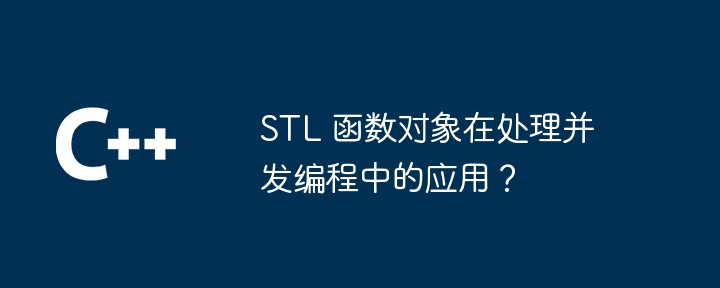在并发编程中,stl 函数对象可以通过以下应用简化并行处理:并行任务处理:封装函数对象为可并行执行的任务。队列处理:存储函数对象,并将它们调度到不同线程。事件处理:将函数对象注册为事件侦听器,在触发事件时执行。

STL 函数对象在处理并发编程中的应用
在并发编程中,函数对象在处理复杂且耗时的任务时提供了强大的工具。STL 库提供了丰富的函数对象集合,可简化并行处理并提高代码的可读性和可维护性。
函数对象
函数对象是实现了 operator() 或 call 的类或结构。它们的行为类似于普通函数,但可以作为对象进行传递、存储和操作。
并发编程中的应用
在并发编程中,函数对象可以用于:
std::thread 或 std::async 将函数对象封装成可并行执行的任务。std::queue 存储函数对象,并将它们作为任务调度到不同的线程。实战案例:并行数组求和
考虑一个并行计算数组总和的案例。可以使用以下函数对象对数组进行并行分区和求和:
struct SumPartition {
int operator()(int start, int end) {
int sum = 0;
for (int i = start; i < end; ++i) {
sum += array[i];
}
return sum;
}
int* array;
};以下代码演示如何使用此函数对象进行并行数组求和:
#include <iostream>
#include <thread>
#include <vector>
using namespace std;
int main() {
// 输入数组
vector<int> array = {1, 2, 3, 4, 5, 6, 7, 8, 9, 10};
// 分区大小
int partitionSize = 2;
// 创建线程池
vector<thread> threads;
int numPartitions = array.size() / partitionSize;
// 启动并行求和
for (int i = 0; i < numPartitions; ++i) {
int start = i * partitionSize;
int end = start + partitionSize;
threads.emplace_back(thread(SumPartition(), start, end, array.data()));
}
// 等待线程完成
for (auto& thread : threads) {
thread.join();
}
// 计算最终结果
int totalSum = 0;
for (int i = 0; i < numPartitions; ++i) {
totalSum += SumPartition()(i * partitionSize, i * partitionSize + partitionSize, array.data());
}
cout << "Total sum: " << totalSum << endl;
return 0;
}通过使用 STL 函数对象,可以轻松地并行化数组求和操作,从而提高了整体性能。
以上就是STL 函数对象在处理并发编程中的应用?的详细内容,更多请关注php中文网其它相关文章!

每个人都需要一台速度更快、更稳定的 PC。随着时间的推移,垃圾文件、旧注册表数据和不必要的后台进程会占用资源并降低性能。幸运的是,许多工具可以让 Windows 保持平稳运行。

Copyright 2014-2025 https://www.php.cn/ All Rights Reserved | php.cn | 湘ICP备2023035733号